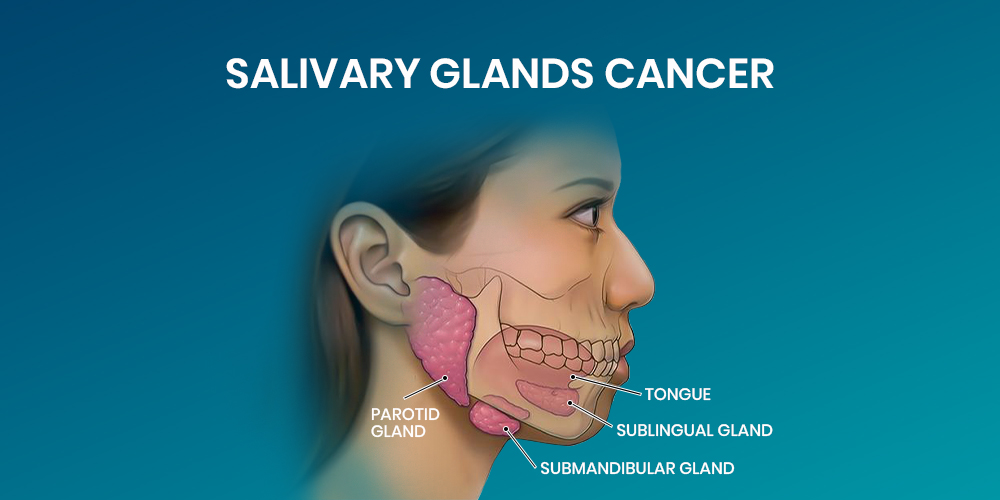
Key Takeaways:
- Salivary Gland Cancer is rare, making up only 1% of head and neck cancers.
- Early signs include facial swelling, numbness, and persistent pain.
- The parotid gland is the most common site for tumors.
- Main types include mucoepidermoid, adenoid cystic, acinic cell, and adenocarcinoma.
- Treatment involves surgery, radiation, or chemotherapy.
- Early detection improves cure chances and survival rates.
Introduction
When we think about cancer, our minds often jump to more common types such as breast, lung, or colon cancer. However, there are rare but significant cancers that affect smaller parts of our body, one of them being Salivary Gland cancer. This uncommon form of head and neck cancer begins in the salivary glands, which are responsible for producing saliva to aid digestion and keep the mouth moist.
Understanding its symptoms, causes, and treatment options can lead to early detection and better outcomes.
What is Salivary Gland Cancer?
Salivary gland cancer refers to malignant tumors that develop in the salivary glands, the glands located in your mouth and throat that produce saliva (or spit) to help start the digestion process.
These salivary gland tumors can be either benign (noncancerous) or malignant (cancerous), and both types can occur in any of the salivary glands.
What is the Frequency of Salivary Gland Cancer? Salivary Gland Cancer Survival Rate
Cancer of salivary gland is uncommon, accounting for only about 1% of all head and neck tumors. Among the various types, mucoepidermoid carcinoma and adenoid cystic carcinoma are the most prevalent, together representing nearly half of all malignant salivary gland tumors.
Salivary Gland Cancer Symptoms
Recognizing salivary gland cancer symptoms early can significantly improve treatment success. The signs often appear gradually and may resemble other, less severe conditions, making them easy to overlook.
Common symptoms include:
- A lump or swelling near the jaw, ear, or neck
- Persistent pain in the face, jaw, or neck area
- Numbness or muscle weakness in part of the face
- Difficulty swallowing or opening the mouth widely
- Fluid discharge from the ear or a persistent sore throat
If these symptoms persist for more than a couple of weeks, it’s essential to see a healthcare provider for evaluation. Early detection of cancer of the salivary gland can make a big difference in treatment outcomes.
The Potential Causes and Risk Factors
The exact cause of Salivary Gland cancer remains unknown, but several risk factors have been identified. Prolonged radiation exposure, whether from previous medical treatments or environmental sources, increases the likelihood of developing this cancer. Additionally, certain occupational exposures, such as working with rubber, asbestos, or industrial solvents, may elevate the risk.
Genetic predispositions, age, and viral infections like Epstein-Barr virus have also been linked to the development of malignant salivary tumors. Though the disease can occur at any age, it is most frequently diagnosed in people over 55.
The Types of Salivary Glands Based on Location
The Parotid Gland
The parotid gland is the largest of all salivary glands and is located just in front of the ears on both sides of the face. It is also the most common site for salivary gland tumors, accounting for approximately 70% of all cases. Most parotid gland tumors are benign, but when they are cancerous, they tend to grow quickly and may invade nearby nerves, causing facial weakness or paralysis.
The Submandibular Gland
Situated beneath the lower jaw, the submandibular gland produces saliva that drains into the mouth under the tongue. Tumors in this gland are less frequent but more likely to be malignant. Because of its deeper location, cancer in the submandibular gland may cause noticeable swelling and discomfort under the jawline. Surgical removal is often required, followed by radiation therapy depending on the tumor’s stage.
The Sublingual Gland
The sublingual gland, found beneath the tongue, is the smallest of the major salivary glands. Cancer of the sublingual gland is extremely rare, but when it does occur, it can be aggressive. Symptoms may include swelling under the tongue, difficulty speaking, or pain while swallowing. Due to its location, treatment typically involves surgery with careful reconstruction to maintain speech and swallowing functions.

Common Types of Malignant Salivary Tumors
There are several histological types of malignant salivary tumors, each with unique characteristics and treatment responses. The most common types include:
Mucoepidermoid Carcinoma
Mucoepidermoid carcinoma is the most frequently diagnosed malignant salivary tumor. It arises from the ductal cells that line the salivary glands and varies in aggressiveness. Low-grade tumors grow slowly and are less likely to spread, while high-grade types are more invasive. Treatment typically includes surgery followed by radiation to ensure complete eradication.
Adenoid Cystic Carcinoma
Adenoid cystic carcinoma is known for its slow growth but high likelihood of recurrence and nerve invasion. Despite being less aggressive initially, it can spread along nerve pathways, making it difficult to treat completely. Long-term follow-up is essential since recurrences can occur even decades later.
Acinic Cell Carcinoma
Originating from the acinar cells that produce saliva, acinic cell carcinoma tends to grow more slowly and often affects the parotid gland. Patients usually experience swelling or a painless lump in the affected area. Surgical excision offers a good prognosis, especially when detected early.
Adenocarcinoma
Adenocarcinoma of the salivary glands develops from the glandular tissue responsible for saliva production. It can vary in grade and aggressiveness. Because it can mimic other tumor types, accurate diagnosis through biopsy and imaging is essential before planning treatment.
How To Diagnose Salivary Gland Cancer?
Diagnosing Salivary Gland cancer involves several steps. First, a physical examination helps identify any lumps or facial nerve weakness. Imaging tests like CT scans, MRIs, or ultrasounds provide detailed insights into the tumor size and spread.
A fine-needle aspiration biopsy (FNAB) or tissue biopsy is the gold standard for confirming cancer. Once diagnosed, staging determines how far the cancer has progressed, guiding doctors toward the most appropriate treatment plan.
What are the Treatment Options?
The main treatment for Salivary Gland cancer is surgical removal of the tumor. Depending on its size and location, nearby tissues or lymph nodes may also be removed. If cancer has spread or if surgical margins are unclear, radiation therapy is used to eliminate remaining cancer cells.
In advanced cases or when surgery isn’t possible, chemotherapy may be combined with radiation to manage symptoms and control tumor growth. Targeted therapies are also being explored, focusing on specific molecular changes within the tumor cells to improve treatment precision. Moreover, clinical research studies in Nebraska are being conducted to help find a better treatment option.
Is Salivary Gland Cancer Curable?
A common question patients ask is, Is salivary gland cancer curable? The answer depends on several factors, including the cancer type, grade, and stage at diagnosis. When detected early, the prognosis is excellent, with many patients achieving complete recovery after treatment. However, aggressive or recurrent types like adenoid cystic carcinoma may require long-term management.
Regular follow-ups and imaging tests are necessary to monitor for recurrence. Early intervention and personalized treatment strategies can significantly improve outcomes and long-term survival.
Conclusion
To conclude, Salivary Gland cancer may be rare, but awareness of its symptoms, causes, and treatment options can lead to earlier diagnosis and better survival outcomes. Whether it originates in the parotid, submandibular, or sublingual glands, prompt medical attention is key.
By recognizing early salivary gland cancer symptoms, understanding the different tumor types, such as mucoepidermoid carcinoma, adenoid cystic carcinoma, acinic cell carcinoma, and adenocarcinoma, and seeking specialized care, patients can significantly improve their chances of recovery.
Additionally, NHO Revive is conducting solid tumor clinical trials to help find a potent treatment option for salivary gland tumors. Enroll with your trusted clinical research organization today and help us find what a better treatment option could look like using the power of oncology research.
FAQs
Can a salivary gland tumor spread?
Yes, malignant salivary gland tumors can spread to nearby tissues, lymph nodes, or distant organs.
Can you survive salivary gland cancer?
Yes, many people survive salivary gland cancer, especially when it’s detected and treated early.
How fast does salivary cancer grow?
The growth rate varies; some salivary cancers grow slowly, while others, like high-grade tumors, can progress rapidly.







